#London school of hygiene and tropical medicine
Text
Issac Choitner continues to do some excellent reporting, asking important questions even when his subject isn't somebody advocating for genocide or admitting they're not good at their job.
This time though it's grim information being delivered. 6,550 excess Gazan deaths over the next month or so is the absolute best case scenario if an immediate ceasefire goes into place and holds. This is according to a joint report from Johns Hopkins University Center for Humanitarian Health and the London School of Hygiene and Tropical Medicine.
It's a short Q&A but well illustrates why we need to stop the fighting NOW.
#issac choitner#the new yorker#gaza#israel#genocide#palestine#Johns Hopkins#London School of Hygiene and Tropical Medicine
5 notes
·
View notes
Text
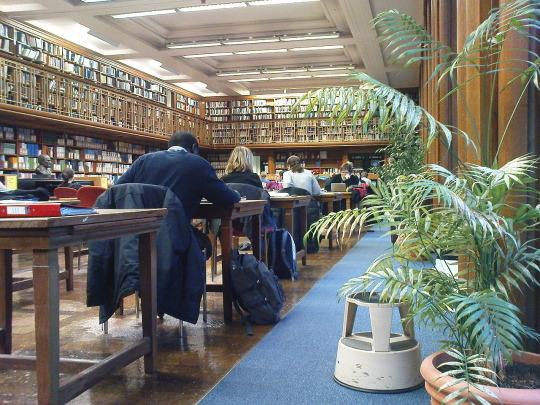
London School of Hygiene & Tropical Medicine
#london school of hygiene and tropical medicine#academia#light academia#medicine#public health#library#medical literature#wikipedia#wikipedia pictures#london#england#europe
121 notes
·
View notes
Text
Auricular Detoxification | SINCERE COMMUNITY
https://sincerecommunity.org/auricular-detoxification

#detox#sincerecommunity#Auricular#adult learning#independent practitioner#arts therapy#affiliation#open university#futurelearn#british red cross#NORDOFF ROBBINS#INPUD#acu-detox plus uk#Bath college#Bark#DHI#developing health and independence#openlearn#London school of hygiene and tropical medicine#quizlet#medicins du monde#elH#British Psychological Society#University of Newcastle Australia#organisation#IPSO#health#wellness#wellbeing#holistic
2 notes
·
View notes
Photo

New study finds 43,000 "excess deaths" may have occurred in 2022 from Somalia drought
Country: Somalia Sources: Food Security and Nutrition Analysis Unit - Somalia, Government of Somalia, London School of Hygiene and Tropical Medicine, UN Children's Fund, World Health Organization Total deaths are projected at up to 34,200 in the first half of 2023, suggesting that, although famine has been averted for now, the crisis is far from over and is already more severe than in 2017-18.
https://reliefweb.int/report/somalia/insight-action-examining-mortality-somalia
#Somalia#Food Security and Nutrition Analysis Unit - Somalia#Government of Somalia#London School of Hygiene and Tropical Medicine#UN Children's Fund#World Health Organization#Food and Nutrition#Health#Analysis#Drought#Epidemic#ReliefWeb - Updates (Headlines)
0 notes
Text

Israel has killed more than 30,000 Palestinians, 40% of whom were children, in less than 5 months. Thousands more are presumed dead under the rubble. Hundreds of thousands of others are at risk of starving to death or dying from disease as Israel withholds food, water, and medicine from entering Gaza. With the Biden administration’s full backing, funding, and arming, Israel has bombed refugee camps and hospitals, killed parents in front of their children, wiped entire family lines out of existence, and, just today, killed over 100 Palestinians as they sought food aid—in addition to committing countless other atrocities against Palestinians in Gaza amounting to the crime of genocide. The scale of this loss is impossible to quantify. Behind every number was a whole person, an individual with hopes and dreams, someone who left behind devastated loved ones. Israel’s genocidal assault is unconscionable—and getting worse. The number of Palestinians killed by Israel could reach an estimated 74,000 in the next 6 months if Israel isn’t stopped, according to a new report from Johns Hopkins and the London School of Hygiene and Tropical Medicine. Link in bio to act now to demand a permanent and immediate ceasefire to save thousands of lives.
#save the children#gaza#save palestine#palestine#save gaza#free palestine#free gaza#فلسطين#jerusalem#i stand with palestine#israel#israeli war crimes#israel is a terrorist state#women rights#feminism
160 notes
·
View notes
Text
Speaking to the Observer, Prof John Edmunds of the London School of Hygiene and Tropical Medicine, who was a member of the Sage committee of advisers to ministers and who has submitted written evidence to the inquiry, said the controversial Eat Out to Help Out scheme – which gave people discounts for eating in restaurants and pubs – was never discussed with scientists.
“If we had [been consulted], I would have been clear what I thought about it,” said Edmunds. “As far as I am concerned, it was a spectacularly stupid idea and an obscene way to spend public money.”
Eat Out to Help Out was launched in August 2020. It allowed diners to claim 50% off more than 160m meals at a cost to the Treasury of about £850m. In the process, it also drove new Covid-19 infections up by between 8 and 17%, according to a study carried out by Thiemo Fetzer, an economist at the University of Warwick, a few weeks later.
[...]
Edmunds said the Sage scientists had no real role in shaping policies across government. “We were asked questions and gave scientific answers but we didn’t know what strategy was being discussed by the government. It was written by them and we saw it the same day that the press saw it.
“They never said: ‘Here’s the strategy, what do you think of it?’ That’s not how it worked and that is why it’s always been so misleading for the government to pretend that it was following science. That’s just nonsense.”
186 notes
·
View notes
Text
Efua Dorkenoo
youtube
Efua Dorkenoo was born in 1949 in Cape Coast, Ghana. For over thirty years, Dorkenoo was at the forefront of the global fight against female genital mutilation, and is credited with helping the problem gain recognition as a public health issue. She studied at the London School of Hygiene and Tropical Medicine, and published the first report in Britain on the topic of FGM. In 1983, Dorkenoo established the Foundation for Women's Health, Research, and Development, which aimed to protect the health and rights of African women and girls. She also worked for the World Health Organization in the 1990s and 2000s.
Efua Dorkenoo died in 2014 at the age of 65.
16 notes
·
View notes
Text




Scottish physician Patrick Manson was born in Oldmeldrum in Aberdeenshire on October 3rd 1844, he is regarded as founder of the field of Tropical Medicine.
Patrick Manson was a son of Alexander Manson and Elizabeth Livingstone Blaikie, his dad was the manager of the local Linen Bank, and Laird of Fingask. His mother was distant relative of the famed Christian missionary-explorer David Livingstone.
He developed a childhood passion in natural history, fishing, shooting, carpentry, mechanics and cricket. Among his Presbyterian-Christian family, he showed excellent memory for memorising church sermons at the age of 5 years. In 1857 his family moved to Aberdeen, where he started his formal education at Aberdeen’s Gymnasium School and continued at West End Academy.
Aged 13 1859 he was apprenticed to Blaikie Brothers “Iron masters” however struck down by a form of tuberculosis he had to leave this job, the ironworks loss would be medicines gain, a year later he entered Aberdeen University where he completed medicine course in 1865 however aged only nineteen and was underage for graduation, so he visited hospitals, museums and medical schools in London. Finally of age he formally graduated in October 1865, and was appointed Medical Officer at Durham Lunatic Asylum.
The following year he gained his Master of Surgery and his Medical Doctorate.
Immediately after qualifying Manson travelled to Formosa (now Taiwan) to take up a post as a medical officer to the Chinese Imperial Maritime Customs. In 1871 he transferred to Amoy, on the Chinese coast, and 13 years later he moved to Hong Kong, where he practiced from 1883 to 1889. Manson developed an early interest in tropical diseases, and in particular in the role of parasites in their transmission. His initial studies were on filaria, a small parasitic worm that causes elephantiasis: and he was able to show that mosquitoes had a key role in transmitting the worms and spreading the disease.
Manson’s discovery helped inform the work of Sir Ronald Ross, who was studying the transmission of malaria in India at the time. While in Hong Kong, Manson helped found the Hong Kong College of Medicine for Chinese, which later formed the nucleus of the University of Hong Kong. He was also the first person to import dairy cattle from Scotland to Hong Kong, starting a dairy industry there supplying hygienic milk affordable by pregnant women, children and patients.
Manson moved to London in 1889 and in 1897 was appointed to the post of Chief Medical Officer to the Colonial Office. Amongst his early initiatives was the foundation of the London School of Hygiene & Tropical Medicine, which opened in 1899. He was elected to the Royal Society in 1900, knighted in 1903 and in the following year awarded an honorary Doctorate of Science by the University of Oxford. In 1907 he became the first president of the Royal Society of Tropical Medicine, and retired from the colonial office in 191
Retiring in 1912 to fish in Ireland Manson returned to London at the beginning of the First World War. Despite crippling attacks of gout he continued to take a lively interest in medical education.
He died in London in 1922 at the age of 78 and is buried at Allenvale Cemetery in Aberdeen.
10 notes
·
View notes
Text
Summary of The Princess Royal's visit to Uganda (25-28 October 2022)

The Princess Royal, accompanied by Sir Tim Laurence, on a four-day visit to Uganda in support of a number of her Patronages.
Day One




The Princess Royal started the visit at the Medical Research Council (MRC), Uganda Virus Research Institute (UVRI) and London School of Hygiene and Tropical Medicine (LSHTM), Ugandan Research Unit.

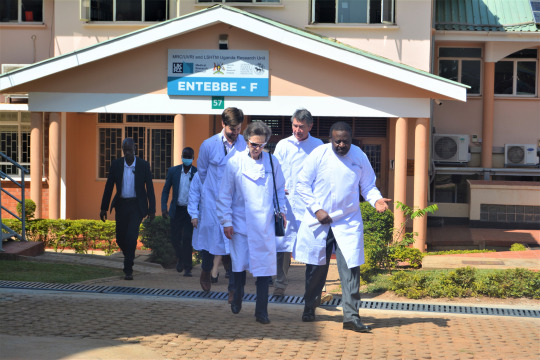

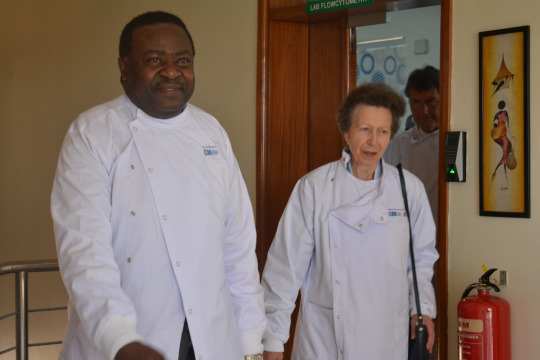


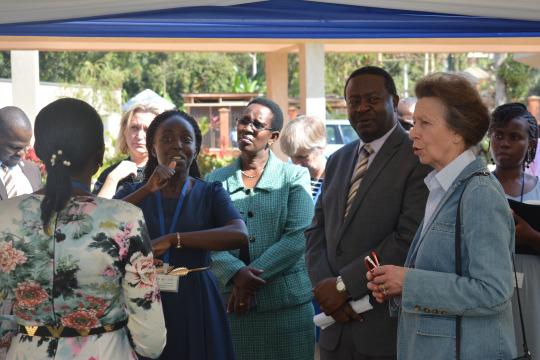
Her Royal Highness is Chancellor of LSHTM, and their Uganda unit is an internationally recognised centre of excellence.
During the visit, The Princess toured the facilities and learnt more about the unit’s work to conduct high quality, energy efficient research that is contributing to the development of strong health policies for the control of infectious and non-communicable diseases.


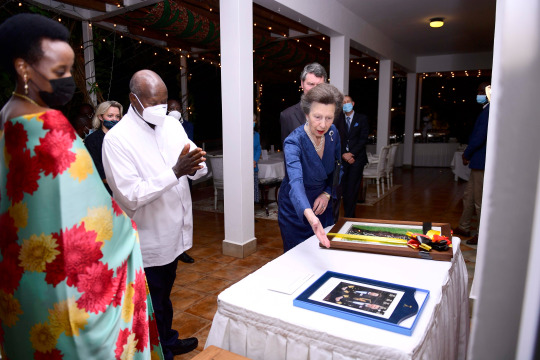

Her Royal Highness later had an Audience with the President of the Republic of Uganda, His Excellency Mr. Yoweri Museveni.
Day Two
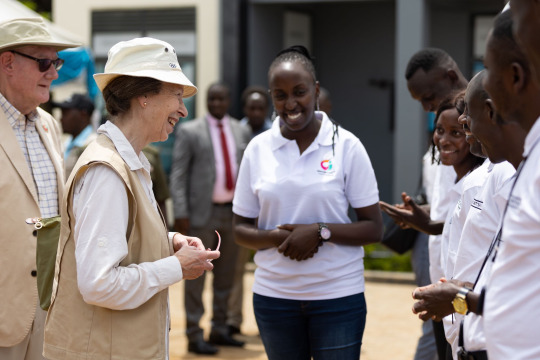

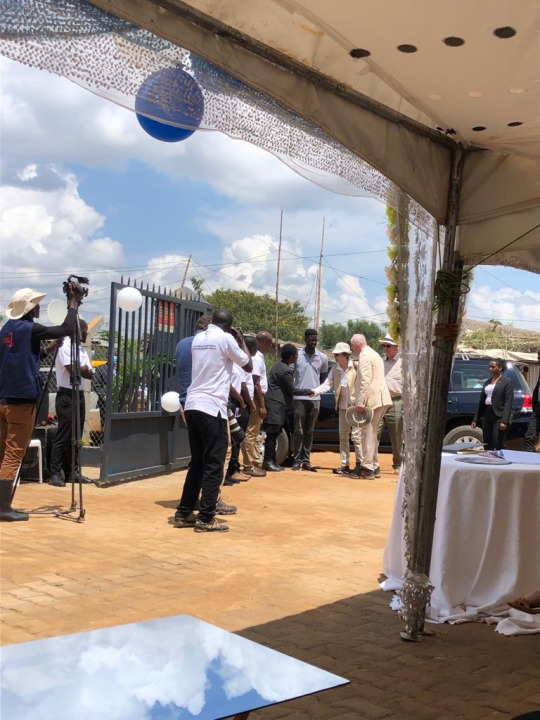
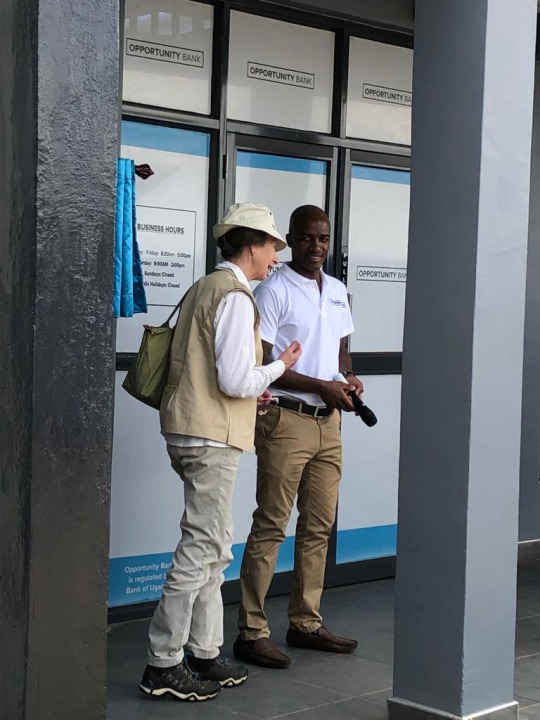
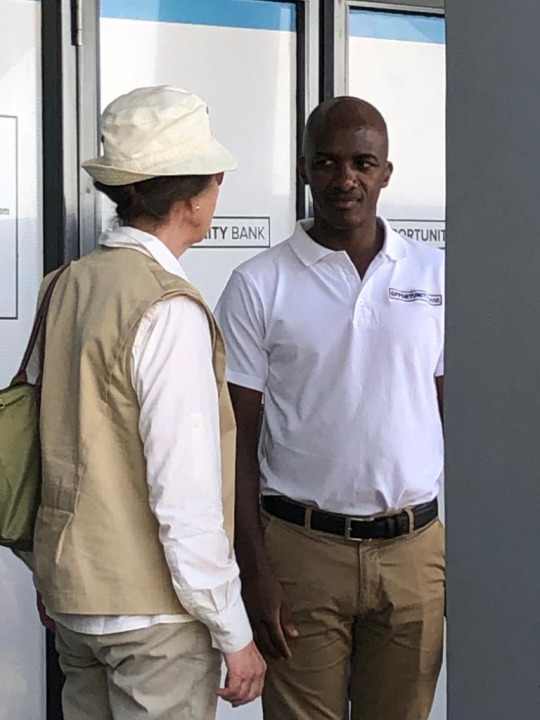
As Patron of Opportunity International UK, The Princess Royal opened Opportunity Bank Uganda Nakivale Branch at the Nakivale Refugee Settlement UNHCR Base Camp.
Opportunity International is a charity that works alongside local partners to ensure that people have the access to loans, training and saving to help to help work their way out of poverty.
Her Royal Highness unveiled a plaque to mark the opening of the charity’s first bank in a refugee settlement.
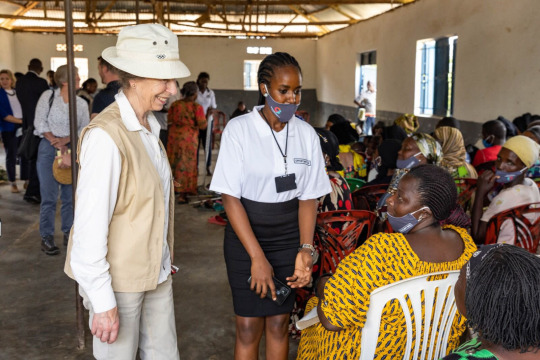
In Sangano, The Princess then met members of the Wenzetu Women's Group to discuss how Opportunity International has worked with the group to assist families of people with disabilities.
Her Royal Highness later visited Unleashed Youth Employment Project to meet refugee entrepreneurs who have benefitted from Opportunity Bank loans.
Day Three
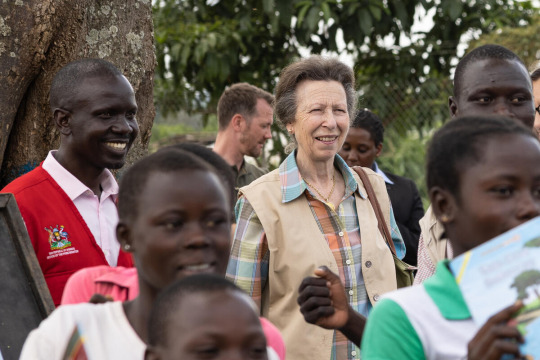


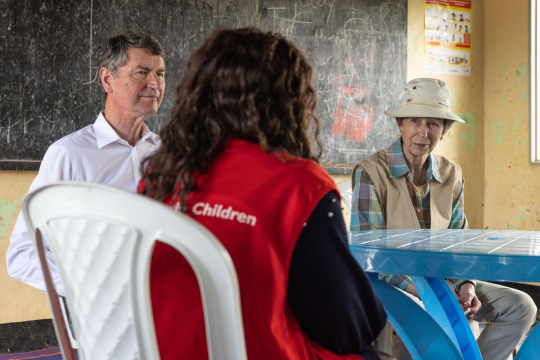
On the third day of Her Royal Highness’s visit, met families in Kyangwali Refugee Settlement in Uganda, to learn more about the impact conflict in the Democratic Republic of Congo (DRC) has had on children’s lives.
Uganda currently hosts 5 million refugees – the largest refugee population in Africa.
The Princess visited a school in Kyangwali Refugee Settlement where she joined a Save the Children Catch-up Club and took part in an activity with children to work together and build a story from pictures.
Later, Her Royal Highness also met children who have fled their homes due to the ongoing conflict in the DRC and are being supported by Save the Children’s child protection activities at a Child Friendly Space.
The Princess Royal became the Patron of Save the Children UK in 2017 after serving as the charity’s President since 1970.
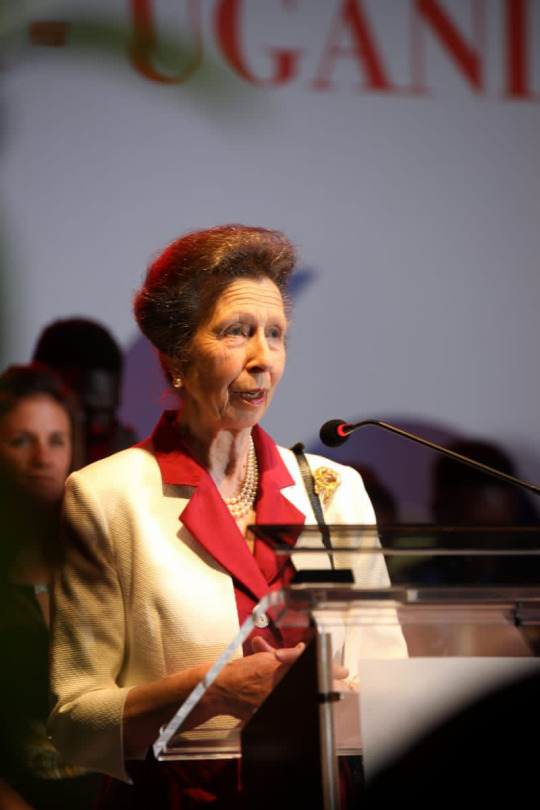

Day Four
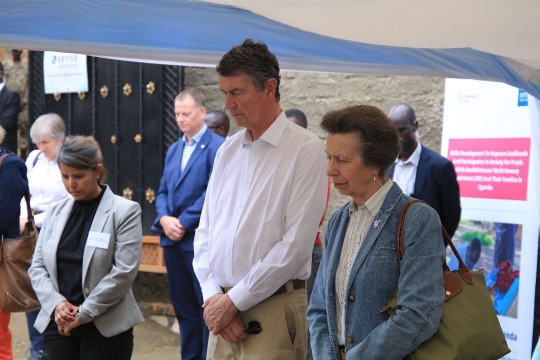
On Friday 28th October, The Princess Royal, as Patron, Sense International, accompanied by Vice Admiral Sir Tim Laurence, was due to visit the Salama School for the Blind in Mukono District, Uganda. As a result of the tragic fire at the school on Monday, Her Royal Highness visited the charity at its Head Office in Kampala, where Her Royal Highness met charity representatives and families it supports. The Princess Royal also had opportunity to pay her respects to those affected, by observing a minutes silence.
Her Royal Highness has shared the following message:
'I was shocked to hear the news of the tragic loss of life. The work of Sense International across many countries is hugely appreciated, working with such a vulnerable group of children. Our thoughts and prayers are with the families and staff.'

To finish her visit in Uganda, The Princess visited the ‘Safe Way Right Way Driver’ Training Centre to learn about Transaid projects in Uganda.
Her Royal Highness toured the driver training yard and met women trainee drivers taking part in the HGV training programme.
Safe Way Right Way’ was launched in 2013 in response to the huge rise in demand for HGV and PSV drivers.
Transaid’s road safety work focuses on influencing safe driver behaviour with long term programmes in Uganda, Tanzania, and Zambia.
Article by The Royal Family
56 notes
·
View notes
Text




We are excited to welcome Her Royal Highness, The Princess Royal to 🇺🇬. The Princess Royal visited the MRC/UVRI & LSHTM Uganda Research Unit today to observe the work they are doing in health research for infectious & non-communicable diseases such as COVID-19 in 🇺🇬, with support from the London School of Hygiene and Tropical Medicine.
@UKinUganda | 25 October 2022
#princess anne#princess royal#tim laurence#timothy laurence#anne does stuff#workanne 9 to 5#uganneda#british royal family#brf
48 notes
·
View notes
Text
Chapter 2 - X-Manson by Doctor Benway - Annotated By Tsar.

Many of you are familiar with Hank "The Tank" McCoy and his works. my college @brw is the formost McCoy Scholar. But as you'll see here this AU's version of Hank takes many cues from his Age of Apocalypse self. But he lacks any kind of the fuzzy goodness of your average Hank McCoy.
Previous Post
Next Post
[Shot of a very large man in an expensive suit in a lushly appointed office, possibly that of an investment banker but possibly that of a professor who is very good at getting grants. The man is wearing rimless high-fashion European glasses and a look of extreme urgency. Plainly, this interview is keeping him from something very important. He also has unusually large hands.]
[Caption: Henry McCoy, Trofim Lysenko Professor of Genetics at Northwestern University, Chicago IL]
*I didn't catch this on my first read through, but Trofim Lysenko is a soviet pseudo-scientist who rejected the idea of Medelivian genetics. He was primarily focused on hybridizing crops by grafting them together. It's frankly bizarre that an american institution in a post-soviet world would have such a position, but it's a weird world, isn't it?
HM: I was at the School For Gifted Youngsters for three of the best years of my life.
Int: You chose to attend?
HM: I had a rough time at my first high school, very rough. It was in the Midwest, where any deformities would make one the object of the most vicious ridicule. At the School, I set myself on the path to understanding that which had made me different.
Int: You worked with Charles Xavier on his genetic experiments?
HM: Charles Xavier had a profound intellect. Everything I am today I owe to him. His breakdown and demise were most unfortunate.
Int: You are aware of the controversy surrounding his background?
HM: Overblown, completely overblown. Xavier had a remarkable mind, one that transcended the petty certifications that we so often use to indicate the size of a mind.
Int: Such as your PhD from Princeton?
HM: Such as that, yes. I am certain that Charles Xavier could have easily attained all that I learned at Princeton in a much shorter time, had he not known it already. He was a most remarkable teacher, and I am but a humble fool by comparison.
*Simp.
Int: Were you close to the other students?
HM: As close as my studies would allow. My program of study was quite intensive, and I spent little time with them. I found their company pleasant, when I had time to indulge in it.
Int: Were they happy at the School?
HM: So far as I knew.
Int: What do you think happened to Robert Drake?
HM: I have no idea. He was still there when I left the School and went up to Princeton.
Int: Didn't you stay in touch with the others?
HM: I had limited contact with the Professor. Otherwise, I lost touch with them. I certainly wish I had not, knowing now what happened. If only I had known, I might have been able to prevent it.
[Shot of a much less well-appointed office with no windows but plenty of steam pipes. The place is in a state of almost pure chaos, with books and papers piled on every free surface. A middle aged man who obviously runs marathons is staring a little too keenly into the camera.]
[Caption: Sir Bernard Quatermass, RA Fisher Professor of Eugenics at the London School of Hygiene]
*Bernard Quartermass is another cross-media reference. He is derived from a 1955 british sci-fi serial called "The Quartermass Experiment. Quartermass is however not a Professor of Eugenics but an Aerospace Engineer.
**The London School of Hygiene is somewhat real, The London School of Hygiene and Tropical Medicine has had a few reports of eugenicist attitutes and white supremacy stances, though that can be expected from an institution that was founded as Britain was colonizing the world.
BQ: McCoy would sell his own mother to the gypsies to get the Nobel. For that matter, he missed his mother's funeral on account of some experiment he was involved in. Disgusting man. No one with any sense of honour will work with him.
*The only reason why B.Q isn't seen as a monster is because he is being placed in comparrison with this AU's Hank McCoy.
Int: Why is that?
BQ: His early career consisted almost entirely of publishing work weeks or even days ahead of others who had been working on their ideas for decades.
Int: So he had no ideas of his own?
BQ: Oh no, no, no. He did have some very good ideas, completely original ones as far as anyone could tell. He developed the anti-retrovirals that cured that awful venereal disease that the Africans caught from monkeys and that infected all those pederasts in California twenty years back. He has a better understanding of mutant genetics than almost anyone in the field. Of course, he would have, given his connections.
*evil Hank McCoy cured AIDS.
Int: How do you mean?
BQ: His work, and indeed all of our work, depends upon getting large quantities of genetic material in a fresh condition. He's always had and still has the best supplies of it.
Int: This material, it comes from cadavers?
BQ: Cadavers and those on their way to becoming them. It may be something as simple and harmlessly taken as blood, it might be a pituitary gland torn from a technically still-living brain. Brain, kidney, and liver tissue in particular can't be taken ethically until the source has died, and Henry always has had an unusually good supply of brains and kidneys.
*i think Bernard is jealous because he wants to get in on some illegal organ harvesting.
Int: You're suggesting that he may have gotten these by illegal means?
BQ: All I'm saying is, he always had tissue, whenever he needed it. If you want a subject for another documentary, try looking at how much cable traffic there is from his lab to China every time they have one of their anti-corruption campaigns.
[Shot of Dwight Hammer]
DH: The autopsy report on Robert Drake showed that he was missing several organs.
Int: Which ones?
DH: Brain, both kidneys, liver. Maybe more, he was down in that muck over ten years, but the coroner was sure that those ones were missing.
Int: Were any of the other bodies found in the lake missing organs?
DH: Some of them. Usually brains. Only one of the bodies was fully intact, the one that they call the Lady of the Lake. Some of the live ones we arrested were missing parts. Summers was missing a kidney and both eyes.
*two victims in the lake now, six remaining:
Robert Drake
Rogue
Int: What do you think happened to them?
DH: We know what happened to Summer's eyes, but we don't know what happened to his kidney. Maybe they ate it. Just assumed it was some sort of mutant thing.
*i think they took Summers' eyes as a means of keeping him powerless to stop them.
Int: Did you vote for the Kelly Amendment?
DH: Way I see it, the founding fathers set everything up assuming we were all equal. There's no call to make some more equal than others.
Int: So you don't feel that mutants need extra protection?
DH: Hell, no. Some of my best friends are mutants, and they never complained.
#marvel#xmen#xmen fanfiction#annotated fanfiction#hank mccoy#beast#bobby drake#tw cannibalism#tw gore#tw eugenics#tw organ harvesting#Trofim Lysenko#bernard quartermass
2 notes
·
View notes
Photo

Vaccines and gene-edited mosquitoes can help cut down malaria deaths by 75% by 2030 according to the London School of Hygiene and Tropical Medicine. This would avert almost 20 million deaths by 2050. https://ift.tt/VPCFM6d
11 notes
·
View notes
Text

London School of Hygiene & Tropical Medicine
#public health#architecture#london school of hygiene & tropical medicine#london#keppel st#wikipedia#wikipedia pictures#medicine
12 notes
·
View notes
Text
25 October 2022
St. James's Palace
The Princess Royal, accompanied by Vice Admiral Sir Tim Laurence, this afternoon arrived at Entebbe International Airport and was received by the British High Commissioner to the Republic of Uganda (Her Excellency Ms. Kate Airey).
Her Royal Highness, Chancellor, University of London, and Patron, Liverpool School of Tropical Medicine, accompanied by Admiral Laurence, visited Medical Research Council/Uganda Virus Research Institute and London School of Hygiene and Tropical Medicine Uganda Research Unit, Plot 51-59 Nakiwogo Road, Entebbe.
The Princess Royal, Patron, Opportunity International UK, and Patron, Save the Children UK, accompanied by Vice Admiral Sir Tim Laurence, later attended a Reception at the Residence of the British High Commissioner in Kampala.
The President of the Republic of Uganda, accompanied by Mrs. Natasha Karugire Museveni (daughter), called upon Her Royal Highness and Admiral Laurence at the Residence this evening and remained to Dinner.
Court Circular
3 notes
·
View notes
Text
Monkeypox outbreak questions intensify as cases soar | Science

The sudden appearance of monkeypox in 13 countries on four continents has jolted the public health community into action. A much milder cousin of smallpox that sporadically causes small outbreaks in Africa, monkeypox is thought to spread slowly and is unlikely to be a pandemic in the making. But scientists worry about the spread among men who have sex with men (MSM), who make up a disproportionate number of the cases so far. The outbreak is a strange and unsettling return to the spotlight for poxviruses, a largely forgotten threat since the World Health Organization (WHO) declared smallpox eradicated in 1980.
The current outbreak surfaced on 7 May in the United Kingdom, which so far has confirmed 20 cases. In the past 3 days, more than 100 suspected cases were reported in Spain, Portugal, the United States, Canada, Sweden, Italy, Belgium, France, Germany, the Netherlands, Australia, and Israel. David Heymann, an epidemiologist at the London School of Hygiene & Tropical Medicine who helped eradicate smallpox and first worked on a large monkeypox outbreak in Africa 25 years ago, expects “many more cases” to come to light in the days and weeks ahead.
Monkeypox virus typically spreads by close contact and respiratory droplets, but sexual transmission appears to be contributing to this outbreak. “This is not typical at all,” says epidemiologist Rosamund Lewis, WHO’s lead for poxvirus diseases. “We should definitely be concerned about this new situation, which has literally just come about in the last 5 days.” WHO’s Strategic and Technical Advisory Group on Infectious Hazards with Pandemic and Epidemic Potential, which Heymann heads, met today to develop recommendations covering everything from the need for more aggressive surveillance to the use of monkeypox vaccines.
“Monkeypox” is a misnomer; the virus was discovered in 1958 in a colony of research monkeys, but its natural hosts are most likely rodents and other small mammals. The virus first surfaced in humans in 1970 in what is now the Democratic Republic of the Congo, causing fever, headaches, and lymph node swelling followed by an eruption of pus-filled blisters resembling smallpox lesions. Outbreaks occur occasionally in sub-Saharan Africa after someone comes in contact with an infected wild animal, and infected travelers sometimes carry the disease to other countries. In 2003, the United States had 47 cases that were linked to pet prairie dogs infected by other species imported from Ghana.
Most people recover within a few weeks. The Congo Basin strain kills up to 10% of those infected, but the recent outbreak appears to only involve the West African strain, which in past outbreaks had a fatality rate of about 1%.
Outbreaks “generally fizzle out on their own,” Lewis notes, because many infected people never infect anyone else. This outbreak, however, “is on such a broad geographic area that overall this number of suspected cases seems to be surprisingly high.”
Although “really rare and unusual,” the outbreak is not likely to become a major threat outside the MSM community, says Agam Rao, a scientist in the poxvirus and rabies branch of the Centers for Disease Control and Prevention (CDC), which confirmed the first U.S. case. “It’s a small subset of the population, and we don’t expect it to be taking off the way COVID-19, for example, took off,” Rao says.

Scabs cover the skin lesions developed by a child and an adult who contracted monkeypox in the United States in 2003.CDC/Getty Images
Multiple introductions?
The first reported case in the current outbreak is a traveler who on 4 May returned to the United Kingdom from Nigeria, a monkeypox hot spot. Clinicians confirmed the patient had monkeypox 3 days later. But that person had no connection to any of the other cases detected to date, according to the UK Health Security Agency, suggesting there may have been multiple introductions from Africa.
Yesterday, a team led by João Paulo Gomes at Portugal’s National Institute of Health posted the first full genome of the virus, which most closely resembles viruses that travelers exported from Nigeria in 2018 and 2019 to Singapore, Israel, and the United States. The Portuguese researchers sequenced the virus from a sample collected on 4 May, which means the infected person likely had no connection to the index patient in the United Kingdom. At the time, Portuguese doctors had no idea what caused their patient’s lesions, Gomes says, and they didn’t test the sample until they learned of the unusual clusters of cases in the United Kingdom. “No one could imagine a case of monkeypox,” he says.
Indeed, monkeypox is so rare that few doctors have ever seen a case. Its lesions resemble those seen with other diseases such as chickenpox and syphilis, and most doctors would not think to test for it. In addition to time-consuming tests that require sequencing the large virus—about 20 times larger than HIV—labs can also use the polymerase chain reaction assay, which can probe samples for tiny bits of monkeypox viral DNA and then amplify it to detectable levels.
Sexual transmission of monkeypox has never been proved, although Nigerian researchers in a 2017 report suspected it might have occurred, because several patients had genital ulcers. Fernando Simón, who directs the Spanish Ministry of Health’s coordination center for health alerts and emergencies, says all seven of the confirmed cases reported on 19 May in Spain were MSM or transgender people who had attended sex parties. (Spain today reported an additional 23 suspected cases.)
“Most of the cases have lesions exclusively perigenital, perianal, and around the mouth,” Simón says. There is no evidence that semen can transmit the virus. “So far, the most acceptable hypothesis is that it is transmitted after the contact with lesions.” But he stresses that transmission could have occurred by contact that did not involve sex.
None of the patients in Spain so far became severely ill or remain hospitalized. Two have HIV infections that are well controlled with medication. MSM and transgender communities have a high prevalence of HIV, but there’s no evidence that compromised immune systems have played any role in this outbreak. Health officials in many affected countries have, for privacy reasons, offered few details about the infected people. (Simón notes that small groups on social media have used the occasion to make offensive remarks about gay, bisexual, and transgender people. “It’s a pity, but these groups exist,” he says.)
It’s possible that monkeypox began to spread in MSM well before May, Heymann says, but wasn’t detected. Transmission may have been at a very low level during COVID-19 lockdowns, he speculates, “and then all of a sudden, things opened up and people begin living their lives again.”
Filling a niche
Monkeypox’s cousin, smallpox, was a major scourge for centuries that killed up to 30% of those infected. A massive global campaign in the 1960s and ’70s brought transmission to a halt; today, the virus is the only human pathogen to have been eradicated, although samples still exist at laboratories in Russia and the United States. As cases plummeted in the early ’70s, countries began to stop using the smallpox vaccine because its risks outweighed potential benefits. The vaccine contained a labmade virus called vaccinia that replicates inside the recipient and sometimes caused severe side effects, killing one in 1 million vaccinated people. WHO’s vaccination campaign ended in 1977, the last year a natural case of smallpox occurred.
Smallpox infections and the smallpox vaccine both protect against monkeypox, so an increasing number of people have become vulnerable to monkeypox over the past 50 years. Some researchers have worried that monkeypox might evolve to fill the “ecological niche” left behind by smallpox. Indeed, reported cases have steadily increased in Africa over the years—and the new outbreak is the first one to take place on several continents simultaneously.
Two vaccines that protect against smallpox and monkeypox are available in Europe and North America. One, manufactured by Emergent BioSolutions, is similar to the vaccine used during the eradication campaign and can still cause severe disease and even death in people who have compromised immune systems. The other, from Bavarian Nordic, uses a nonreplicating form of vaccinia, specifically designed to cause fewer side effects. It is the only vaccine explicitly approved for monkeypox.
Vaccines in short supply
Earlier this month, the United Kingdom started to offer vaccines to health care workers who had been in contact with monkeypox patients. Spain has yet to do so, says Simón, who notes that the country’s infectious disease clinicians have the personal protective equipment and experience to protect themselves. Massachusetts General Hospital, which is caring for the only confirmed case in the United States, also has not offered staff a vaccine. They, too, take appropriate precautions, says Paul Biddinger, who heads the hospital’s center for disaster medicine. But even though the United States has approved vaccines, clinicians cannot prescribe them: They only exist in a national stockpile that CDC controls. For now, it deems health care workers at the hospital in an “intermediate” risk category that doesn’t warrant vaccination.
The vaccines, which prevent disease even if used up to 4 days after a person is exposed to the virus, could also be used to protect contacts of suspected or confirmed monkeypox cases. So far, no countries have announced plans to do so. Both vaccines are in short supply and typically only available through national stockpiles.
In a bizarre coincidence, Bavarian Nordic held a meeting with Heymann and nine other public health leaders from around the world this week, planned 6 months ago, to discuss the need for more countries to stockpile its vaccine, given the increase in monkeypox cases over the past few years. “We were really thinking that experts in this field and authorities need to start to reflect on it,” says Bernard Hoet, the company’s vice president of medical strategy. “A company like ours cannot stockpile for all the countries forever. Today we have some doses available and we are going to distribute them, but how do you want us to decide if they go here or there?”
Drugs also exist to treat severe cases of monkeypox. One, tecovirimat, in 2018 became the first drug approved by the U.S. Food and Drug Administration (FDA) to treat smallpox after it proved safe in human trials and effective in animals given closely related viruses. Based on similar data, FDA approved a second drug for smallpox, brincidofovir, last year.
Although drugs and vaccines offer hope for limiting the severity and scope of this outbreak, a WHO statement issued on 18 May cautions that “these countermeasures are not yet widely available.” And alarm bells will likely ring louder and louder if cases continue to mount and the virus surfaces in ever more countries.
New post published on: https://livescience.tech/2022/05/21/monkeypox-outbreak-questions-intensify-as-cases-soar-science/
4 notes
·
View notes
Text
A baby born prematurely and spent 8 months in the NICU was adopted by married nurses who treated her
In 2020, a Lancet study shows that 13.4 million babies were born prematurely, or 37 weeks before full pregnancy.
That’s approximately 1 in every 10 births worldwide.
This study involved WHO, UNICEF, and the London School of Hygiene and Tropical Medicine researchers.
Being born prematurely is one of the major causes of early baby deaths. Advances in medicine have significantly improved the…
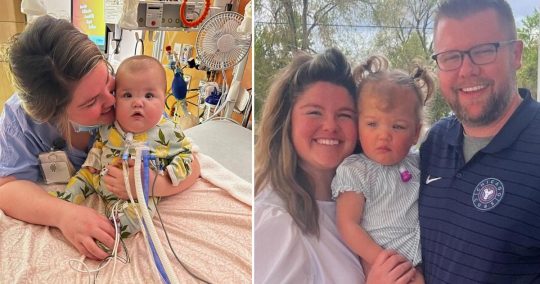
View On WordPress
0 notes